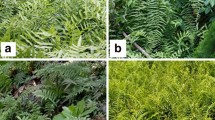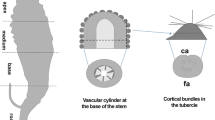Abstract
Molecular studies indicate that Penaeaceae, Oliniaceae, and the monospecific families Alzateaceae and Rhynchocalycaceae form a clade of Myrtales. Of these four families, Penaeaceae have tracheids with vestured pits, whereas the others have septate fibers lacking vestures; all have vestured pits in vessels. Tracheid presence in Penaeaceae may be related to the arid South African habitats of the family. Presence of vestures on tracheids in families with vestured vessel pits is one indication that imperforate elements are tracheids and are conductive cells, whereas fiber-tracheids and libriform fibers are non-conductive. Tracheids occur widely in angiosperms and may be plesiomorphies or apomorphies. Combretaceae, the first branch of the Myrtales clade, has a great diversity of vesture features in vessels compared to the Penaeaceae alliance families. Alzatea has vestures that spread over the inside of the vessels, whereas in most taxa of the alliance, vestures are confined to the pit cavities and pit apertures. Vestures in the alliance tend to be globular in shape, and are bridged together by strands of wall material. Lignotubers and roots in Penaeaceae have vestures much like those in stems. Only a few species and genera (notably Alzatea) of the alliance have vesture features the pattern of which correlates with the current taxonomic system. Vestured pits should be viewed from the inside surface of vessels as well as the outer surface, and although sectional views of vestured pits are infrequent, they are very informative. Studies that explore diversity from one order or family to another are needed and offer opportunities for understanding the evolutionary significance of this feature.










Similar content being viewed by others
Literature cited
Baas, P. 1979. The anatomy of Alzatea Ruiz & Pav. (Myrtales). Acta Botanica Neerlandica 28: 156–158.
Bailey, I. W. 1933. The cambium and its derivative tissues. VIII. Structure, distribution, and diagnostic significance of vestured pits in dicotyledons. Journal of the Arnold Arboretum 14: 259–273.
——. 1936. The problem of differentiation and classification of tracheids, fiber-tracheids, and libriform fibers. Tropical Woods 45: 18–23.
Bridgwater, S. D. & P. Baas. 1978. Wood anatomy of the Punicaceae. IAWA Bulletin 1978/1: 3–6.
Carlquist, S. 1966. Wood anatomy of Compositae: a summary, with comments on factors influencing wood evolution. Aliso 6(2): 1–25.
——. 1974. Island biology. Columbia University Press, New York.
——. 1975. Ecological strategies of xylem evolution. University of California Press, Berkeley.
——. 1983. Wood anatomy of Onagraceae: Further species; root anatomy; significance of vestured pits and allied structures in dicotyledons. Annales of the Missouri Bototanical Garden 69: 755–769.
——. 1984. Vessel grouping in dicotyledon woods: Significance and relationship to imperforate tracheary elements. Aliso 10: 505–525.
——. 1988a. Comparative wood anatomy. Springer Verlag. Berlin & Heidelberg.
——. 1988b. Wood anatomy of Drimys (Winteraceae). Aliso 12: 81–95.
——. 1989. Wood anatomy of Tasmannia; summary of wood anatomy of Winteraceae. Aliso 11: 257–275.
——. 2001. Comparative wood anatomy. Ed. 2. Springer Verlag, Berlin & Heidelberg.
——. 2014. Fiber dimorphism: Cell type diversification as an evolutionary strategy in angiosperm woods. Botanical Journal of the Linnean Society 177: 44–67.
——. 2016. Wood anatomy of Brassicales: New information, new evolutionary concepts. Botanical Review 82: 24–90.
—— & L. DeBuhr. 1977. Wood anatomy of Penaeaceae: comparative, phylogenetic, and ecological implications. Botanical Journal of the Linnean Society 75: 211–227.
——, B. Hansen, H. H. Iltis, M. E. Olson & D. L. Geiger. 2013. Forchhammeria and Stixis (Brassicales): Stem and wood anatomical diversity, ecological and phylogenetic significance. Aliso 31: 59–75.
Dickie, J. B. & P. E. Gasson. 1999. Comparative leaf anatomy of the Penaeaceae and its ecological implications. Botanical Journal of the Linnean Society 131: 327–351.
Gilg, E. 1894. Penaeaceae and Oliniaceae. In: A. Engler & K. Prantl (eds.), Die natürlichen Pflanzenfamilien, vol. III, Abt. 6, 208–216.
Goldblatt, P. & J. Manning. 2000. Cape plants. A conspectus of the Cape flora of South Africa. Strelitzia 9: 1–722.
Holbrook, N. M. & M. A. Zwieniecki. 1999. Embolism repair and xylem tension: Do we need a miracle? Plant Physiology 120: 7–10.
Jansen, S., P. Baas & E. Smets. 2001. Vestured pits: Their occurrence and systematic importance in eudicots. Taxon 50: 135–167.
——, ——, P. Gasson & E. Smets. 2003. Vestured pits: Do they promote safer water transport? International Journal of Plant Sciences 164: 405–413.
——, ——, ——, F. Lens & E. Smets. 2004. Variation in xylem structure from tropics to tundra: Evidence from vestured pits. Proceedings of the National Academy of Sciences 101: 8834–8837.
Jeje, A. A. & M. H. Zimmermann. 1979. Resistance to water flow in vessels. Journal of Experimental Botany 30: 817–827
Kohonen, M. M. 2006. Engineered wettability in tree capillaries. Langmuir 22: 3148–3153.
—— & A. Helland. 2009. On the function of sculpturing in xylem conduits. Journal of Bionic Engineering 6: 324–329.
Lens, F., P. Gasson, E. Smets & S. Jansen. 2003. Comparative wood anatomy of epacrids (Styphelioidese, Ericaceae s. l.). Annals of Botany 92: 835–856.
McCully, M., M. Canny, A. Baker & C. Miller. 2014. Some properties of the walls of metaxylem vessels of maize roots, including tests of the wettability of their lumenal wall surfaces. Annals of Botany 116: 1–13.
Meylan, B. A. & B. G. Butterfield. 1974. Occurrence of vestured pits in the vessels and fibres of New Zealand woods. New Zealand Journal of Botany 12: 3–18.
—— & ——. 1978. The structure of New Zealand woods. DSIR Bulletin 222. New Zealand Department of Scientific and Industrial Research, Wellington.
Ohtani, J. 1987. Vestures in septate wood fibres. IAWA Bulletin, new series, 8: 59–67.
——, B. A. Meylan & B. G. Butterfield. 1984. Vestures or warts—proposed terminology. IAWA Journal 5: 3–8.
Parham, R. A. & M. M. Baird. 1974. Warts in the evolution of angiosperm wood. Wood Science and Technology 8: 1–10.
Sano, Y., H. Morris, H. Shimada, L. Ronse de Craene & S. Jansen. 2011. Anatomical features associated with water transport in imperforate tracheary elements of vessel-bearing angiosperms. Annals of Botany 107: 953–964.
Scholander, P. F., H. T. Hammel, E. A. Hemmingsen & W. Garey. 1962. Salt balance in mangroves. Plant Physiology 37: 722–729.
Schönenburger, J. & E. Conti. 2003. Molecular phylogeny and floral evolution of Penaeaceae, Oliniaceae, Rhynchocalycaceae, and Alzateaceae (Myrtales). American Journal of Botany 90: 293–309.
Stevens, P. 2001 onwards. Angiosperm phylogeny website, Version 13 (accessed February 2016).
van Vliet, G. J. C. M. 1975. Wood anatomy of Crypteroniaceae sensu lato. Journal of Microscopy 104: 65–82.
——. 1978. Vestured pits of Combretaceae and allied families. Acta Botanica Neerlandica 27: 273–285.
——. 1979. Wood anatomy of the Combretaceae. Blumea 25: 141–223.
Wagner, W. L., D. R. Herbst & S. H. Sohmer. 1990. Manual of the flowering plants of Hawai’i. University of Hawaii Press & Bishop Museum Press, Honolulu.
Wardrop, A. B., W. Liese & G. W. Davies. 1959. The nature of wart structures in conifer tracheids. Holzforschung 13: 115–127.
Zimmermann, M. H. 1983. Xylem structure and the ascent of sap. Springer Verlag, Berlin & Heidelberg.
Acknowledgements
Special mention should go to the work of Ger J. C. M van Vliet and others in the wood anatomy of Myrtales project, which was the idea of Pieter Baas, and which has produced a number of excellent studies. Individuals who provided me with material include David Boufford, Vicki Funk, and Chris Niezgoda. My fieldwork in South Africa was aided by grants from the National Science Foundation and the Simon Guggenheim Foundation. That fieldwork would have not been successful without the help of Elsie Esterhuysen (University of Cape Town) and the staff of the Compton Herbarium (especially John Rourke). Thanks go to Steve Windhager, for availability of a scanning electron microscope at Santa Barbara Botanic Garden.
Author information
Authors and Affiliations
Corresponding author
Rights and permissions
About this article
Cite this article
Carlquist, S. What the Penaeaceae alliance (Myrtales) tells us about the nature of vestured pits in xylem. Brittonia 69, 276–294 (2017). https://doi.org/10.1007/s12228-017-9477-1
Published:
Issue Date:
DOI: https://doi.org/10.1007/s12228-017-9477-1




